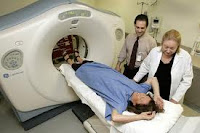 |
| CT scans reduce lung cancer mortality |
Lung cancer is the leading cause of cancer deaths in the United States and worldwide, and researchers have found that early diagnosis can help to improve survival rates. But a usual technology for screening—the chest x-ray—isn't sensitive enough to detect small tumors in the lung. A new study reveals that there may be a better screening tool.
Low-dose helical computed tomography, sometimes called spiral or helical CT, has emerged as a more sophisticated tool for lung cancer screening. Helical CT creates a series of cross-sectional images that can give physicians a clearer look at the lungs. Helical CT can pick up tumors well under 1 centimeter (cm) in size, while chest x-rays detect tumors about 1 to 2 cm (0.4 to 0.8 inches) in size.
To test the benefits of helical CT, researchers enrolled over 53,000 current and former smokers aged 55 to 74 in the National Lung Screening Trial (NLST). Each volunteer received three screenings over three years with either a standard chest x-ray or a helical CT.
Low-dose helical computed tomography, sometimes called spiral or helical CT, has emerged as a more sophisticated tool for lung cancer screening. Helical CT creates a series of cross-sectional images that can give physicians a clearer look at the lungs. Helical CT can pick up tumors well under 1 centimeter (cm) in size, while chest x-rays detect tumors about 1 to 2 cm (0.4 to 0.8 inches) in size.
To test the benefits of helical CT, researchers enrolled over 53,000 current and former smokers aged 55 to 74 in the National Lung Screening Trial (NLST). Each volunteer received three screenings over three years with either a standard chest x-ray or a helical CT.
The results showed that there were 20% fewer lung cancer deaths in the helical CT group than in the x-ray group. The findings were announced by the National Cancer Institute (NCI), a sponsor of the study. Because these results were so significant, it was recommended that the study be ended early.
"This is the first time that we have seen clear evidence of a significant reduction in lung cancer mortality with a screening test in a randomized controlled trial," said Christine Berg, M.D., NLST project officer, in an NCI news release. "The fact that low-dose helical CT provides a decided benefit is a result that will have implications for the screening and management of lung cancer for many years to come."
Researchers are investigating whether there are risks of radiation exposure associated with repeat low-dose helical CT scans. It's important to note that low-dose helical CT delivers a much lower dose of radiation than a regular diagnostic CT scan.
Despite these encouraging findings, researchers were quick to note that advanced screening isn't the best way to beat lung cancer. "[G]iven the high association between lung cancer and cigarette smoking, the trial investigators re-emphasize that the single best way to prevent lung cancer deaths is to never start smoking, and if already smoking, to quit permanently," said Denise Aberle, M.D., NLST national principal investigator.
To get information and assistance on smoking cessation, visit smokefree.gov or call the Smoking Quitline at 1.877.44U.QUIT (1.877.448.7848). NCI smoking cessation counselors can give help and provide answers to smoking-related questions in English or Spanish by phone Monday through Friday from 8 a.m. to 8 p.m., Eastern time.
Source:National Cancer Institute (NCI); The National Lung Screening Trial: Overview and Study Design. Radiology 091808; Published online November 2, 2010, doi:10.1148/radiol.10091808
Source:National Cancer Institute (NCI); The National Lung Screening Trial: Overview and Study Design. Radiology 091808; Published online November 2, 2010, doi:10.1148/radiol.10091808